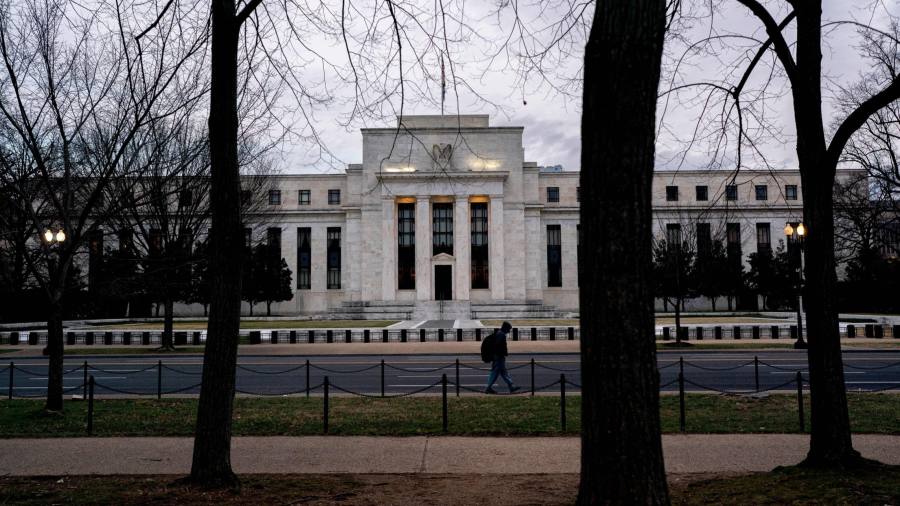Costs of dangerous US corporations’ debt have risen sharply this yr as buyers guess the Federal Reserve will deliver inflation below management with out triggering a dangerous recession.
Yields on US junk bonds — debt bought by companies with low credit score rankings — have fallen by a couple of proportion level for the reason that finish of 2022, in keeping with an Ice Knowledge Providers index, buying and selling at a median of seven.97 per cent. The decline displays a pointy improve in costs.
In flip, the hole between junk yields and people of US authorities bonds has narrowed by greater than 0.8 proportion factors to lower than 4 proportion factors — the primary time it has sat under that stage since final April.
The shrinking “unfold” implies waning expectations of debt defaults for the $1.8tn low-grade company bond market. It additionally displays continued bets that the Fed will have the ability to loosen up its aggressive tightening of financial coverage earlier than the central financial institution has indicated — lowering the chance of a pointy financial downturn.
“I feel the market’s completely priced for a delicate touchdown,” stated John McClain, portfolio supervisor at Brandywine International Funding Administration. “It’s been a mix of January euphoria, which has led to greater fairness costs, and better fairness costs have pulled alongside high-yield credit score spreads.”

Proof of cooling US inflation has helped to gas the upbeat temper, with December’s client value index studying dropping for the sixth month in a row, down to six.5 per cent from a peak of 9.1 per cent in June.
In flip, futures markets are pricing in expectations that US authorities borrowing prices will rise to a peak of 5.1 per cent in July, earlier than falling to 4.8 per cent by the tip of the yr.
These bets come whilst Fed officers themselves have indicated they count on charges will stay above 5 per cent in December, and after the newest jobs report signalled a hotter-than-predicted labour market.
US employers added 517,000 new roles in January, in contrast with forecasts of 185,000, regardless of the central financial institution’s efforts to pour chilly water on an overheating economic system.
“The macro image has undoubtedly improved, with inflation easing sequentially,” stated Kelly Burton, excessive yield portfolio supervisor at Barings. “The roles knowledge alone [suggests] we’re not heading to a deep recession within the near-term.”
Burton additionally highlighted technical elements driving this yr’s junk bond rally, with spreads and issuance bettering from a weak base.
“We have been coming off a yr with hardly any issuance since corporations have been capable of patiently wait out the volatility,” she stated. “I feel it’s extra of that start line that has generated curiosity in [high-yield] in addition to the technical backdrop”.
Dominique Toublan, US head of credit score technique at Barclays, stated 2023 had begun with folks having “cash to take a position” as a result of that they had “been defensive for fairly a very long time” and there was “slightly little bit of [fear of missing out] occurring”.
On the identical time, he stated, “individuals who had been quick” — betting towards enhancements in credit score costs — “determined to not be quick anymore, so that they eliminated hedges”.
Excessive-yield spreads may proceed to tighten within the short-term, stated Toublan. However he anticipated them widening later this yr, “fairly considerably from the place we’re”.
Marty Fridson, chief funding officer at Livian Lehmann Fridson Traders, additionally predicted the gulf in yields between junk bonds and low-risk Treasuries to broaden. “You continue to have loads of indicators pointing to recession,” he stated.
Spreads may improve by as a lot as two proportion factors, Fridson added, “as that expectation begins to alter from ‘every part’s fantastic, the Fed’s going to pivot, we’re going to have a delicate touchdown’.”
“Traditionally, the high-yield market has not likely anticipated recessions very properly,” he stated. It’s “not unprecedented” for the market to be “ignoring the flashing yellow lights”.
For Brandywine’s McClain, the “conflicting knowledge” of current weeks “offers cowl for the Fed to proceed alongside its path of extra fee hikes adopted by what we consider is an extended pause”.
He predicted a situation the place the US avoids recession was “changing into increasingly seemingly”. Nonetheless, he stated there was a excessive probability that the US economic system would see a pick-up in inflation later this yr which may create recent challenges for the central financial institution.

